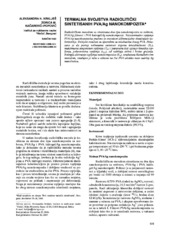| dc.description.abstract | The radiolytic method was used to synthesize two types of nanocomposites with silver, PVA/Ag by film casting and PVA hydrogel/Ag nanocomposites. This method is particularly suitable for generating metal nanoparticles in solution. The radiolytic species (solvated electrons and secondary radicals) exhibit strong reducing properties such that metal ions are reduced at each encounter. Metal atoms then tend to grow into larger clusters. It was found that solid or swollen polymers are able to stabilize small crystallites against spontaneous growth via aggregation. Using differential scanning calorimetry (DSC), the melting behavior and kinetics of the PVA/Ag nanocomposites were investigated and compared to those of pure PVA. The melting as well as crystallization behavior of polymers is crucial because it governs the thermal properties, impact resistance and stress strain properties. Understanding the melting behavior is significant not only to tailor the properties of nanocomposites but to investigate the interactions between the constituents. The DSC curves of pure PVA and prepared nanocomposites show only one melting peak between 175 and 230 degrees C, indicating that the melting behavior of these two systems are analogous. In both cases, with increasing heating rate, the melting peak shifts to a higher temperature, but with increasing Ag content the peak melting temperature is lower. When specimens are heated at high heating rate, the motion of PVA molecular chains cannot follow the heating temperature on time due to the influence of heat hysteresis, which leads to a higher peak melting temperature. When Ag nanoparticles are added they increase the heat transfer among the PVA molecular chains decreasing the melting temperature. The Ag content is a major factor affecting the degree of crystallinity. It was observed that at low nanofiller content, up to the 0.5 wt%, the degree of crystallinity of the nanocomposites increased, while at a higher content the crystallization was retarded. The half time of melting is non-linearly dependent on the amount of nanofiller. In the range from 0.25 to 1 wt% Ag it slightly increases, because at a low Ag content the nanoparticles act as a heterogeneous nucleation agent during the crystallization process. For large amounts of nanofiller, the half time of melting is markedly higher than for pure PVA. At a higher Ag content, the nanoparticles act as a barrier that restricts the thermal motion of PVA molecular chains and the half time of complete melting increases. The significantly lower melting activation energy of the nanocomposites with high amount of nanofiller compared to pure PVA, calculated by the Kissinger method, indicated that nanoparticles reduced the heat barrier for the melting process. | en |

